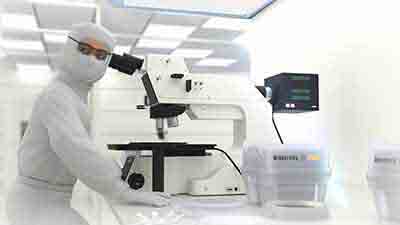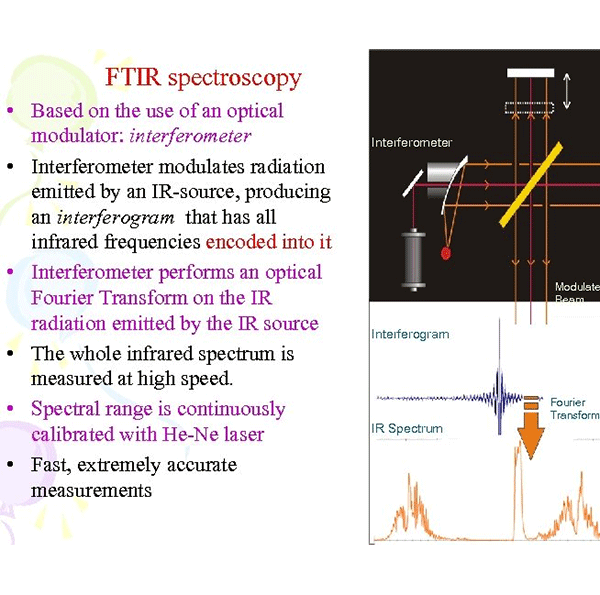I am looking for Si wafers to use as substrates in FTIR measurements. For this, I need the wafers to be as transmissive in the mid-IR as possible. I'm wondering which is a better choice between Boron dopant Si and intrinsic Si. I found two wafer specs #1115 and #3193. Please let me know which is more idea for FTIR measurements. Please also let know if you have other recommendation. I would also appreciate if you could provide the FTIR spectrum for these products.
Silicon Wafers Fourier Transform Infrared (FTIR) Measurement
What Silicon Substrates Work Best For FTIR Measurements?
A PhD candidate requested the following quote:
Question:
When selecting silicon (Si) wafers for FTIR measurements, the primary criterion is their transparency in the mid-infrared (IR) region.
For FTIR measurements where high transparency in the mid-IR region is crucial, the undoped (intrinsic) Si wafer (item #3193) would generally be the better choice. Its high resistivity (>10,000 ohm-cm) and intrinsic nature make it more suitable for transmitting infrared light without significant absorption.
Reference #312484 for specs and pricing.
Get Your Silicon Wafer Quote FAST! Or, Buy Online and Start Researching Today!
Video: Learn about FTIR Measurements
What is Fourier Transform Infrared (FTIR) Measurement?
The basic definition of Fourier Transform Infrared measurement (FTIR) is "the measurement of infrared radiation from a source with a single frequency". The simplest description of FTIR is "a microwave source comprising a source having a frequency which undergoes a phase shift when transformed into or emitted from a microwave cavity". The name "FTIR" was first used in 1958. A more accurate description is "the detection of changes in radiation heat patterns resulting from the interaction of a source and a chosen background". The primary objectives of using an instrument like FTIR for biomedical research are: to determine the physical structure of biological samples; to characterize molecular processes; and to detect a wide range of physical processes occurring in real systems.
Silicon Wafers Used for FTIR
Scientist:
I am looking for DSP Si wafers to use as substrates (or matrices) in FTIR measurements. For this, I need the wafers to be as transmissive in the mid-IR as possible. DSP intrinsic Si is about 60% transmissive. Do you sell any anti-reflective coatings on the wafers to make them more transmissive in this regions? Do you recommend any of your products besides the DSP wafers for this purpose?
UniversityWafer, Inc. Quoted:
6” DSP wafers,Work well for IR are spec’d at:
Type: P
Dopant: Boron
Resistivity: 10 – 20 Ohm cm
Orientation: <100>
Thickness: 625± 25um
Contact us for pricing.
Silicon Wafers Used in FTIR Meaurements
Below are just some recent silicon wafer specs used by our clients for FTIR Measurments. They are high-quality, inexpensive substrates.
Si Item #1583 - 100mm P/B <100> 0.001-0.005 ohm-cm 500um SSP Prime with 300nm of Thermal Oxide
Si Item #452 - 100mm P/B <100)> 0-100 ohm-cm 500um SSP Test Grade
 Definition. In general, the measurement of infrared radiation from a sample must comply with the specific measurement procedures specified in Standard No. 639, Standard Benchmark for Imaging Variances. There are three broad categories of infrared spectroscopy measurement techniques. The first category, Colorimetric Spectroscopy (C Spectroscopy), uses color filters to identify and quantify amounts of various substances as well as any color changes within those substances. The other two categories, Diode Spectroscopy and Gas Chromatography, use different methodologies to measure the composition of a sample, but employ the same filter combination to achieve the result.
Definition. In general, the measurement of infrared radiation from a sample must comply with the specific measurement procedures specified in Standard No. 639, Standard Benchmark for Imaging Variances. There are three broad categories of infrared spectroscopy measurement techniques. The first category, Colorimetric Spectroscopy (C Spectroscopy), uses color filters to identify and quantify amounts of various substances as well as any color changes within those substances. The other two categories, Diode Spectroscopy and Gas Chromatography, use different methodologies to measure the composition of a sample, but employ the same filter combination to achieve the result.
Spectroscopy. This technique measures the amount of infrared radiation emitted or absorbed by a sample. The most common device for this is a scanning plate such as a quartz plate or an optical media reader. Since the emitted light comes from charged particles, the dominant light is red, which can be easily detected on a periodic basis by a spectroscopic spectrophotometer.

Diode Crystallography. A diode crystal is formed by crystal diffusion after it is deposited on a substrate. The impure gas or liquids that are present when the crystal forms may have different concentrations. When the applied voltage and current are applied, changes in the temperature of the liquid or the applied electric field lead to differences in the concentrations of the lighter chemicals present in the crystal. Due to this, there may be peaks and valleys in the electric field resulting in differences in the concentrations of various compounds, such as oxygen, in the bulk of materials deposited on the crystal. As a result, this technique produces a record of the structure of crystals upon which the applied voltage and current are measured.
Multilayer Films. There are many applications in which the observation of single wavelengths or a collection of wavelengths at different wavelengths is crucial for determining properties of interest. Examples include polarimetry, mass Spectrometry, and nondestructive testing. In the case of polarimetry, a thin film is applied to a substrate with correlated polarizations. The thickness of this thin film is controlled, and a peak intensity profile is then extracted from the multilayer film by exposing the film to varying voltages and intensities.
H Thioure Transient Transients. An H Thioure Transient instrument is a very fast and accurate measurement method but is less sensitive than other methods. A transient probe consists of two mirrors, one with a positive charge electrode, the other negative. When the mirrors are placed close to each other and an electrical current is passed through them, they each emit photons as they switch places.
Figure 2: Transient Solutions. In a Fourier Transform Infrared measurement, a high-frequency electric field sweeps through a medium, such as a quartz plate or a wafer of plastic. The frequency of passing light through the Transient Solution causes excited atoms to emit radiation. This is the basis for measuring the total absorption as well as the total mobility of molecules in the solid.
For better results, the h-factor needs to be calculated and this is done with the aid of Laser irradiation Spectroscopy (LIS). A Transient Solution, also known as a LIS spectra passes through a series of alternating Fresnel angles. For the purposes of this discussion, we restrict our discussion to the single-particle absorption and mobility properties of H Thioure Transient Solutions.
Silicon Crystals for FTIR Spectroelectrochemistry
A PhD in Chemistry requested the following quote:
Do you sell doped ATR Ge or Si crystals for FTIR spectroelectrochemistry? I found a paper from 2016 from the laboratory of Prof. Andreas Erbe that cites you as the source of Sb-doped Ge ATR crystals. I would be very interested in any information you might have about such crystals, and likely purchasing some.
Our need is for doped silicon or germanium ATR crystals for an FT-IR spectrophotometer. They need to be doped enough to be conductive but still sufficiently transparent in the IR region. Other members of the project I’m in have been surface-doping commercial Si ATR crystals themselves, with sufficient success that we are ready to purchase some. I read in a paper that someone doing IR had used some of your doped germanium, but going back to that paper perhaps I misunderstood and they used only a flat wafer, not an ATR crystal (see attached).
Is doping an ATR crystal to be used in a spectrophotometer something that you have done or are interested in? If you are interested, I can get more specific specs for conductivity and transparency from the other groups in this project.
Reference #273880 for specs and pricing.
How To Select Silicon Wafers For FTIR Measurements
When selecting silicon (Si) wafers for FTIR measurements, the primary criterion is their transparency in the mid-infrared (IR) region. Here’s a comparison based on the specifications you provided:
-
P-type Boron doped Si wafer (100mm, <100> orientation, 10-20 ohm-cm, 500um DSP Prime):
- This wafer is doped with Boron, which introduces impurities into the silicon lattice. Dopants like Boron can affect the infrared transmission properties of the wafer, typically reducing transparency in the mid-IR region compared to intrinsic (undoped) silicon.
-
Undoped (Intrinsic) Si wafer (100mm, <100> orientation, >10,000 ohm-cm, 525um double side polished Prime):
- This wafer is undoped (intrinsic), meaning it has minimal impurities intentionally introduced into the silicon lattice. Intrinsic silicon tends to be more transparent in the mid-IR region compared to doped silicon because there are no additional impurities to absorb infrared light.
Recommendation: For FTIR measurements where high transparency in the mid-IR region is crucial, the undoped (intrinsic) Si wafer (specification #2) would generally be the better choice. Its high resistivity (>10,000 ohm-cm) and intrinsic nature make it more suitable for transmitting infrared light without significant absorption.
FTIR Spectrum: Unfortunately, I cannot provide specific FTIR spectra for the products mentioned here. Typically, manufacturers or suppliers of silicon wafers may provide optical transmission spectra or data sheets that include information on transparency in the infrared range. You might want to check with the supplier or manufacturer for detailed spectral data specific to these wafers.
Other Recommendations: If you require even higher transparency or have specific wavelength ranges of interest, you could consider:
- Ultra-high resistivity (e.g., >1,000,000 ohm-cm) undoped silicon wafers.
- Silicon-on-Insulator (SOI) wafers which have a silicon layer on a buried oxide layer, offering good transparency in the mid-IR depending on the oxide thickness.
- Epi-polished silicon wafers, which are polished to reduce surface roughness and can enhance optical transparency.
Always verify with the supplier for detailed specifications and transmission data relevant to your application to ensure the chosen wafer meets your specific FTIR measurement requirements.
